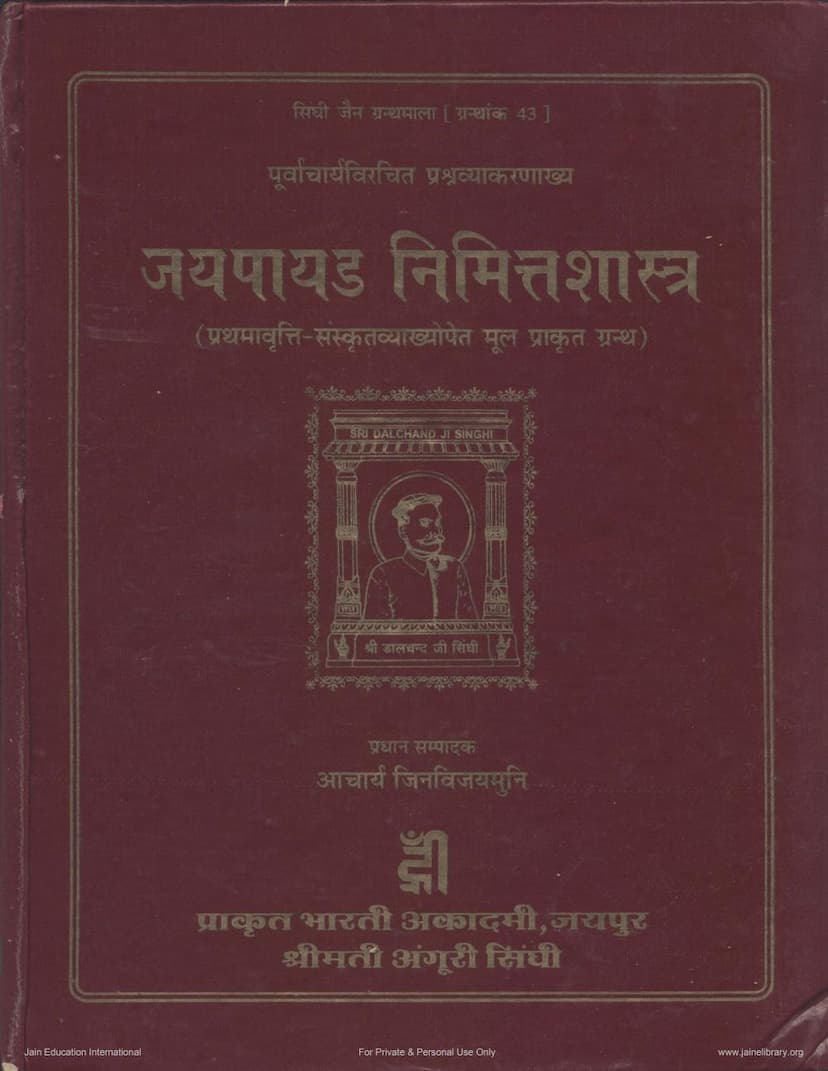Jaypayad Nimmittashastra
Added to library: September 2, 2025

Summary
The Jain text "Jayapad Nimitta Shastra" (also known as Prashna Vyakarana) by Jinvijay, published by Prakrit Bharti Academy, is a significant work within the Jain tradition focusing on the science of prognostication and divination. The provided text consists of an introduction and portions of the work itself, detailing its historical context, the editorial efforts, and some of the core principles of the text.
Here's a comprehensive summary:
1. Historical and Editorial Context:
- Legacy and Preservation: The introduction highlights the Jain tradition's long-standing commitment to the creation and preservation of literature, with both monastic and lay communities contributing to a vast collection of manuscripts. The work of Munishri Jinvijay in editing and publishing rare Jain texts, supported by the Singhi family, is emphasized.
- The Singhi Jain Granthamala: This publication is part of the "Singhi Jain Granthamala," a series established in memory of Shri Dalchand Ji Singhi by his son Babu Bahadur Singh Ji Singhi. This series aimed to publish valuable Jain works using modern scholarly methods.
- Revival and Re-publication: The introduction mentions that the Singhi Jain Granthamala experienced a pause after the passing of its key figures. However, Prakrit Bharti Academy undertook the re-publication of these valuable texts, which had become scarce and sought after by researchers. This re-publication was made possible by the generous financial support of the Singhi family, specifically Shri Ranjan Singhi.
- The Text's Significance: "Jayapad Nimitta Shastra" is presented as the second gem in this re-publication series, following "Kathakosh Prakaran." It's noted to be a work on "Prashna Vidya" (the science of questions or divination) within the broader field of "Nimitta Shastra" (the science of prognostics).
2. Content and Subject Matter:
- Prashna Vidya (Divination): The core subject of the text is "Prashna Vidya," a practice rooted in ancient Indian traditions where scholars sought knowledge of unknown elements and future events through various contemplative and experimental methods. These were often codified into secret systems.
- Astrology and Symbolism of Letters: The text delves into the analysis of letters (varnas) and their symbolic meanings, qualities, and influences. It posits that ancient sages used contemplation and experimentation to understand abstract principles and phenomena.
- The Alphabet as a System: The text elaborates on the Indian alphabet, tracing its lineage to the Brahmi script. It categorizes the 45 letters into vowels (12) and consonants (33), further dividing them into seven groups based on their phonetic origins (e.g., 'a', 'ka', 'cha', 'ta', 'pa', 'ya', 'sha').
- Classifications of Letters: It explains that letters are classified based on various attributes, including:
- Gender/Nature: "Jiva-sanjnak" (life-related), "Dhatu-sanjnak" (element/metal-related), and "Mula-sanjnak" (root/fundamental-related).
- Qualities and States: Terms like "Abhidhūmita" (fumigated), "Āliṅgita" (embraced), and "Dagdhā" (burnt) are used to describe the states or characteristics of letters.
- Phonetic Origin: Letters are categorized based on their place of articulation in the vocal tract (e.g., urasya - from the chest, kanthya - from the throat, jihvamūlīya - from the root of the tongue, tālavya - from the palate, etc.).
- Positional Attributes: Concepts of "Uttarādhara" (upper/lower) are introduced, classifying letters and their combinations to reveal specific meanings.
- The "Jayapad" Name: The title "Jayapad" is discussed, with the editors noting that while the manuscript title initially read "Jayapāhuḍa," further consideration suggests "Jayapāyaḍa" is the more appropriate rendering, as used in the third verse of the original text.
- Mysterious and Esoteric Nature: The text is described as a "mysterious and wonderful science" (vilakṣaṇa aura adbhut rahasyamaya shastra) that was considered highly confidential, with only a select few having access to its knowledge. This explains its rarity and obscurity.
- Scope of Application: A detailed table of contents ("Vishayanukram") reveals the text covers a wide range of topics within divination, including various types of prognostications related to time, circumstances, elements, creatures, and human affairs.
- Structure of the Text: The text includes sections on "Samāsika Shiksha Prakaran" (Lesson on Compound Forms), "Sankata-Vikat Prakaran" (Difficult and Critical Aspects), "Uttarādhara Prakaran" (Upper and Lower Aspects), and numerous other specific analytical categories related to letters, their combinations, and their interpretive significance.
- Connection to Keval Jñana: It is believed that masters of this science can attain a form of knowledge akin to that of an omniscient being (Kevali Parigyan), leading to its appellations like "Kevali Chudamani."
3. Key Principles Illustrated (Based on excerpted verses):
- Invocation: The text begins with invocations to the Jina and the goddess of knowledge (Shruta-Devata).
- The Power of Letters: It emphasizes that letters are not merely sounds but possess specific qualities and can indicate various states and phenomena, especially when combined.
- Classification and Interpretation: The detailed classification of letters based on phonetic origin, vowel combinations, and symbolic states (like āliṅgita, abhidhūmita, dagdha) forms the basis for interpretation in different contexts (Jiva, Dhatu, Mula).
- Divinatory Process: The text outlines a method involving the analysis of questioned letters, their combinations, their inherent qualities (like auspiciousness or inauspiciousness), and their positional attributes (Uttara-Adhara) to answer specific questions about an individual's fortune, misfortune, life, and death.
- Specific Examples: The verses illustrate how vowel-consonant combinations, the influence of vowels (like short vs. long, different phonetic qualities), and the relationships between letters from different phonetic classes determine the outcome of the prognostication. The text also introduces concepts of celestial bodies (Sun, Moon, planets) being associated with specific letters and their influences.
- The Goal: The ultimate goal is to gain precise and factual knowledge about matters like profit/loss, auspiciousness/inauspiciousness, happiness/sorrow, and even life/death, based on the analysis of these letter-based systems.
In essence, "Jayapad Nimitta Shastra" is a complex system of divination within Jainism that uses the alphabet as a primary tool for understanding and predicting various aspects of life, drawing upon intricate symbolic associations and classifications of letters, vowels, and their combinations. The re-publication by Prakrit Bharti Academy makes this historically significant and esoteric text accessible to modern scholars and practitioners.